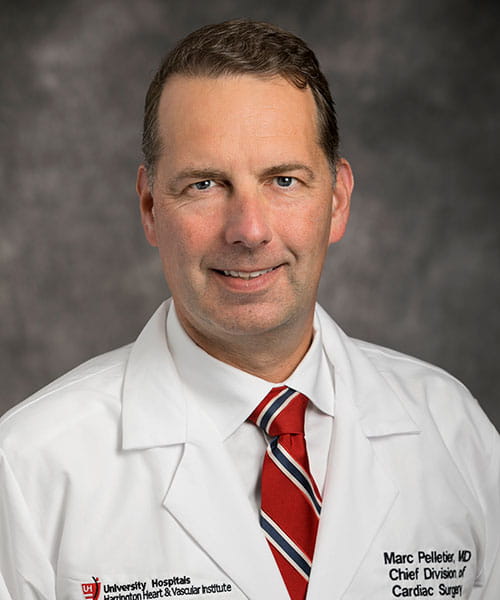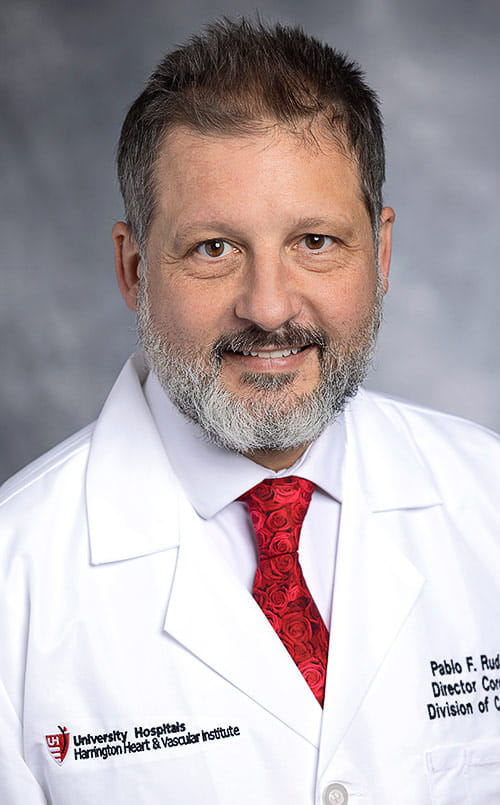University Hospitals Harrington Heart & Vascular Institute Grows to Become Nation’s 4th Largest MIDCAB Program
February 27, 2023
Innovations in Cardiovascular Medicine & Surgery | Winter 2023
In 2022, cardiac surgeons within University Hospitals Harrington Heart & Vascular Institute averaged nearly two Minimally Invasive Direct Coronary Artery Bypass (MIDCAB) procedures per week. First offered at University Hospitals in 2021, the novel grafting technique provides an alternative to open-heart surgery for a narrow subset of patients who require revascularization of the anterior wall of the left ventricle.
 Marc Pelletier, MD
Marc Pelletier, MD Pablo Ruda-Vega, MD
Pablo Ruda-Vega, MDTypically, candidates for MIDCAB are individuals who need a bypass graft to the left anterior descending artery (LAD) using the left internal mammary artery (LIMA). “We know from a prognostic point of view that a LIMA to LAD graft is the gold standard and consistently improves survival,” says Marc Pelletier, MD, director of the UH Harrington Heart & Vascular Institute Heart Surgery Center, Division Chief of Cardiac Surgery for University Hospitals Cleveland Medical Center, and the Jay Ankeney Professor at Case Western Reserve University School of Medicine.
According to data tracked by the medical device supplier, University Hospitals now has the fourth largest MIDCAB program nationwide. “This is a program that barely existed two years ago, but we devoted time and energy to it and have been able to grow to the point that we are now one of the busiest centers in the country,” says Dr. Pelletier. “The technique has enabled a change in the philosophy that everyone needs a full sternotomy. We can treat appropriately selected patients successfully through a mini thoracotomy.”
MIDCAB is technically demanding. When the procedure is performed at high-volume health systems like University Hospitals, outcomes are associated with lower postoperative mortality and morbidity.1 Specialists at UH Harrington Heart & Vascular Institute are highly skilled at the perioperative evaluation and procedural intricacies required for a successful MIDCAB program.
“We have been able to become one of the biggest centers in the country because we are truly a team,” says Pablo Ruda Vega, MD, director of Cardiac Surgery at UH Lake Health and Director of the Cardiac Surgery Network at University Hospitals Cleveland Medical Center. “We have tremendous involvement from our cardiologists and cardiac surgeons, and I am grateful for the support of our leadership and colleagues.”
For Some Patients, a Two-Part Approach
“MIDCAB is interesting because it provides the opportunity to treat complex patients with a two-stage hybrid process,” says Dr. Ruda Vega. Rather than performing a full sternotomy revascularization, blood flow is restored through a combination of MIDCAB and stenting. “There are some patients who may have additional lesions, but we know that a typical open-heart surgery might be too risky or debilitating,” says Dr. Pelletier. “With a hybrid process, one of the cardiologists will stent, let’s say, the back of the heart. That allows us to return when the patient is stable and use MIDCAB to graft the LAD.” Other potential candidates include patients who have LAD occlusion, complex proximal lesions, stenosis following prior stenting, or medical complexity that precludes open-heart surgery.
Weekly Collaboration
MIDCAB is just one of many leading-edge treatment options offered within UH Harrington Heart & Vascular Institute. Interventional cardiologists and surgeons hold weekly Comprehensive Heart Assessment Team (CHIT) meetings to present complex or compelling cases. “These discussions have furthered collaboration between our cardiologists and surgeons,” says Dr. Ruda Vega. “Additionally, every patient considered for a minimally invasive approach is evaluated by at least two surgeons.” Between 10 and 20 specialists gather each week to review patient histories and studies and determine the best course of action together.
Improved Patient Satisfaction
“A common patient fear is having to go through their breastbone,” says Dr. Pelletier. “When we can offer some patients a much less invasive procedure, it alleviates their worries and reduces post-operative discomfort.” Some patients also prefer mini thoracotomy for cosmetic reasons to avoid a long scar on their chest. MIDCAB provides an easier recovery and excellent cosmesis when compared to open-heart revascularizations.
An International Consortium
UH Harrington Heart & Vascular Institute surgeons and cardiologists are also participating in an international consortium of hybrid revascularization, with Dr. Pelletier and Dr. Ruda Vega serving in leadership roles. Cardiac specialists from the United States, Canada and Europe meet virtually to analyze cases. “As we continue to track outcomes and ensure that our patients are well-served, we are committed to advancing innovative multispecialty revascularization techniques on an international level,” says Dr. Ruda Vega.
For more information or to refer a patient, email Dr. Pelletier at Marc.Pelletier@UHhospitals.org or Dr. Ruda Vega at Pablo.RudaVega@UHhospitals.org.
1. Garg, Sheena., Raja, Shahzad G. (2020). Minimally invasive direct coronary artery bypass (MIDCAB) grafting. AME Medical Journal. 5(0). https://amj.amegroups.com/article/view/5468/html
Contributing Experts:Marc Pelletier, MD
Director, Heart Surgery Center
University Hospitals Harrington Heart & Vascular Institute
Division Chief, Cardiac Surgery
University Hospitals Cleveland Medical Center
Jay Ankeney Professor
Case Western Reserve University School of Medicine
Pablo Ruda Vega, MD
Director, Cardiac Surgery, UH Lake Health
Director, Cardiac Surgery Network
University Hospitals Cleveland Medical Center


